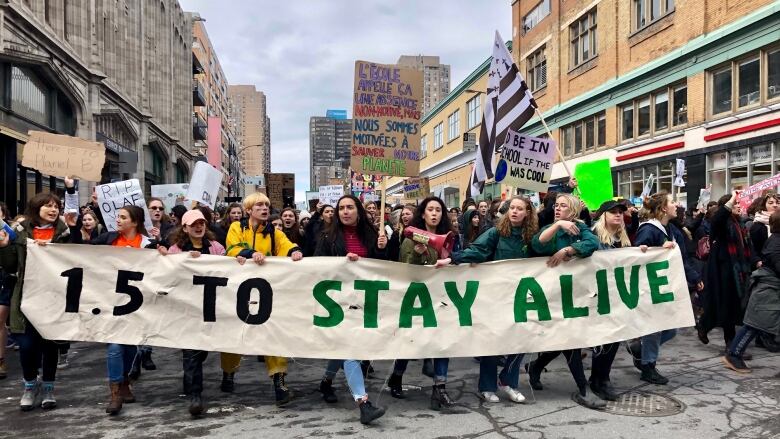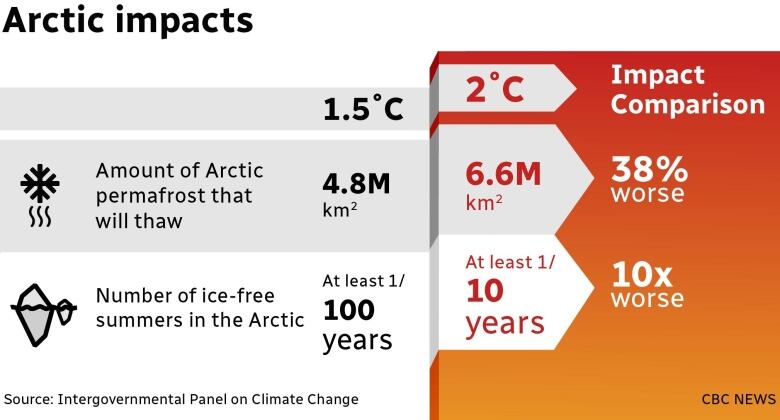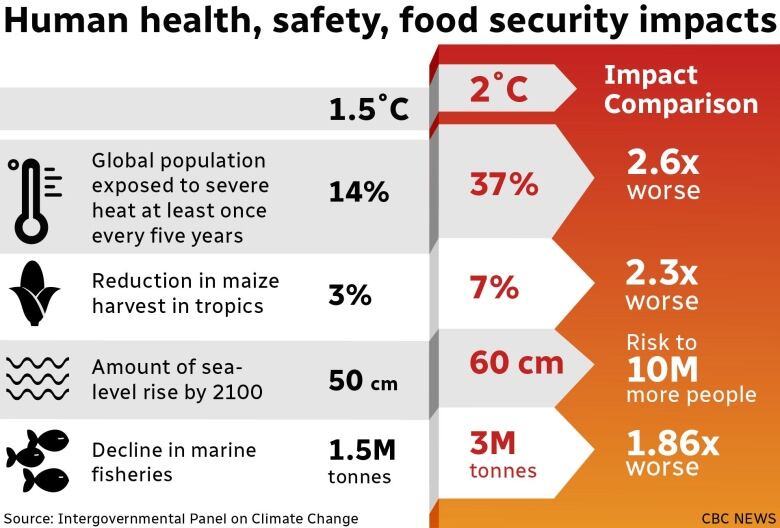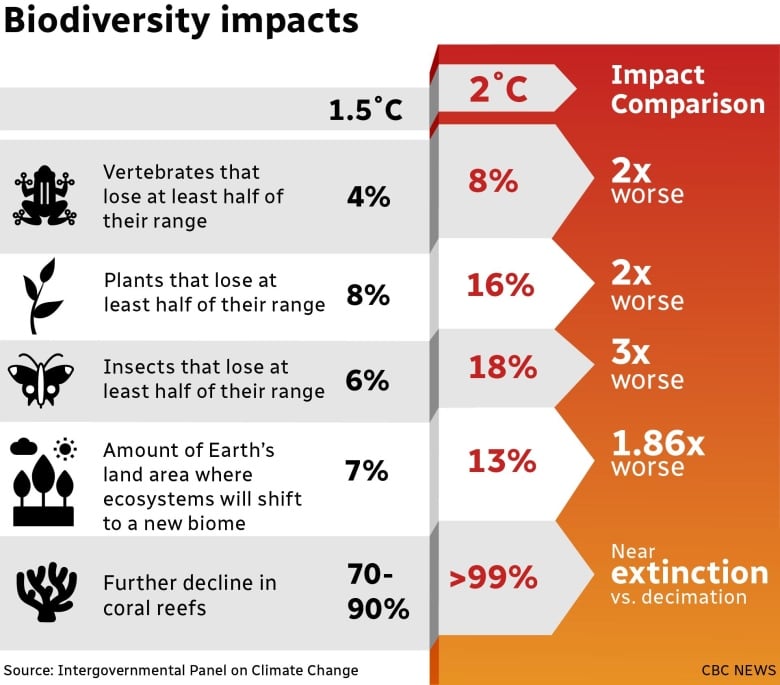How shaving half a degree off global warming targets could lessen the effects of climate change
A key goal of COP26 is to keep the goal of limiting global warming to an increase of 1.5 C 'within reach'

Our planet is changing. So is our journalism. This story is part of a CBC News initiative entitled "Our Changing Planet" to show and explain the effects of climate change and what is being done about it.
Keeping a 1.5 C limit on global warming "within reach" is one of the key goals of the ongoing United Nations climate conference, COP26. That's the lower of two targets in the 2015 Paris Agreement on climate change. But why are there two targets? What's the difference between them in terms of impacts? Are they both reachable? Here's a closer look.
What are the official targets to limit global warming?
Article 2.1.aof the Paris Agreement names a key goal as: "Holding the increase in the global average temperature to well below 2 C above pre-industrial levels and pursuing efforts to limit the temperature increase to 1.5 C above pre-industrial levels, recognizing that this would significantly reduce the risks and impacts of climate change."
- Have questions about COP26 or climate science, policy or politics? Email us:ask@cbc.ca. Your input helps inform our coverage.
One of the key goals of COP26, which opens on Oct. 31 in Glasgow, is to "Secure global net zero by mid-century and keep 1.5 degrees within reach."
Net zeromeans we areno longer addingheat-trapping greenhouse gases to the atmosphere.Some greenhouse gases might still be emitted, but they would be"cancelled out" by the removal of an equivalent amount of greenhouse gases. (This is very similar tocarbon neutrality, but includes more than just CO2.)
So far, the world has warmed 1.1 C above pre-industrial temperatures, the United Nations reports.
The Conference of Parties (COP), as it's known, meets every year and is the global decision-making body set up to implement theUnited Nations Framework Convention on Climate Change, adopted in the early 1990s, and subsequent climate agreements.
WATCH | Inaction and inequity key concerns ahead of COP26 climate summit
Why are there two targets in the Paris Agreement?
UN negotiations had been looking at a target of 2 C for a long time. But in 2010, there was an agreement to review by 2015 whether the science suggested that goal needed to be strengthened. That included consideration of a 1.5 C goal, which had been called for by some groups representing developing countries. Among them was the Alliance of Small Island States (AOSIS), which represents many vulnerable countries in UN climate negotiations.
"That process concluded that the globally agreed goal of two degrees as a kind of guardrail was not safe for the most vulnerable," said Frances Fuller, the advisor on mitigation and science for AOSIS.
The group and its peers pushed hard during Paris negotiations, and eventually the 1.5 C target was added as one to work towardin the longer-term.
WATCH | What half a degree of warming could mean for climate change
What is the difference between the climate impacts of 1.5 C and 2 C?
The Intergovernmental Panel on Climate Change (IPCC)released a special report looking into the difference between 1.5 C and 2 C of warmingin 2018.
Compared to 1.5 C of warming, an extra half a degree of warming would lead to more intense and frequent extremes of heat, heavy rainfall and drought, the report found.
"Every bit of global warming matters and makes things worse," said Kirsten Zickfeld, professor of climate science at Simon Fraser University in Burnaby, B.C., whowas one of the report'slead authors.
In some cases, that worsening is proportional to the amount of warming.
But in other cases, it isn't. Feedback loops amplify the impacts more and more as the temperature increases. That's the case for sea ice loss in the Arctic.The melting of white ice exposes water, which is dark and absorbs more heat, causing the sea ice to melt faster, exposing more water and so on.

That's one of the reasons Canada, and especially its Arctic region, is warming much faster than the world averageand will continue to do so.
"If we talk about 1.5 degrees warming [on average globally], it may actually mean five degrees warming in some regions of the Arctic," said Zickfeld. Meanwhile, an average of 2 C of warming globally might translate to 7 C of warming in parts of the Arctic.
WATCH | Arctic nations discuss mitigating impact of climate change
Scientists are also concerned about tipping points or thresholds that lead to irreversible processes, such as the melting of the Greenland or East Antarctic ice sheets.
Zickfeld said that particular tipping point is estimated to be at around 2 C of warming.
"The likelihood that we will trigger any of these tipping points at 1.5 is less than at two degrees," she said.
"Staying below 1.5 degrees is the only chance we have of avoiding these tipping points and stabilising our world again"
Hear from #COP26 Peoples Advocate, Sir David Attenborough, on why every fraction of a degree matters #TogetherForOurPlanet | #ClimateAction
—@COP26What could the difference meanto humans?
The report showed that a half-degree difference in global temperature could make a dramatic difference in the number of people exposed to risks to their health, safety and livelihoods.
"The global population exposed to increased water shortages would be 50 per cent less under 1.5 C than 2 C," Zickfeld said.
Similarly, impacts on yields of maize, rice, wheat and marine fisheries aren't proportional to the amount of warming with serious consequences for food security.
"Several hundred million fewer people would be exposed to climate-related risks by 2050 and be susceptible to poverty if we limit warming to 1.5 as opposed to 2 C," Zickfeld said.

By 2100, the sea level will be 10 centimetres higher with 2 C of warming than with 1.5 C. While that doesn't sound like a lot, it exposes an extra 10 million people to risks of deadly and damaging flooding from sea level rise.
Fuller said the difference is dire for many of the countries AOSIS represents.
Above 1.5 C, sea level rise will "engulf entire nations," she said. "We cannot let go of the 1.5 goal, and to go beyond that would be accepting the decimation of our communities, livelihoods, nations, culture."
If residents of such countries are forced to flee, the losses go beyond health, safety and economic losses, Fuller said. "You've lost your national identity, you've lost your country," she said. "That's not something we're willing to accept."
WATCH | 'We're beyond urgency,' says Marshall Islands climate envoy
What could happen to other living things on Earth?
Local extinctions of plants, animals, insects and coral reefs are expected to increase much more with 2 C of warming compared to 1.5 C, with the higher limit potentially leading to the nearextinction of coral reefs.

Fuller said the destruction of coral reefs and other coastal ecosystems would also have huge impacts on people.
"Tourism is almost entirely dependent on our coastal ecosystems," she said. "And with that type of sea-level rise, it would mean decimation of entire economies."
WATCH | An impassioned marine biologist on a mission to save the world's reefs
What does 'keep 1.5 C within reach' mean?
IPCCmodelling shows all simple paths that keep warming below 1.5 C require the world to cut emissions to 45 per cent below 2010 levels by 2030 and reach net zero around 2050.
Fuller said that means short-term action and targets in the next 10 years is "really, really important" to ensure the world doesn't blow past 1.5 C.
Currently, countries' pledges to 2030 are on track for to 2.6 C or 2.7 C, while pledges to get to net-zero, mostly by 2050, would reduce that to 2.2 C of warming if fully implemented.
Is that possible?
Zickfeld believes so. "We know what we need to do and we have the means the technological and economic means to do it," she said. "We can do it if political leaders really step up and the global community is committed to achieving this."
Fuller said she heads to COP26 with "cautious optimism."
"I think that there is a lot of momentum at the moment to make some transformational change," she said. "However, we do need to see more."


















_(720p).jpg)


 OFFICIAL HD MUSIC VIDEO.jpg)
.jpg)



























































































